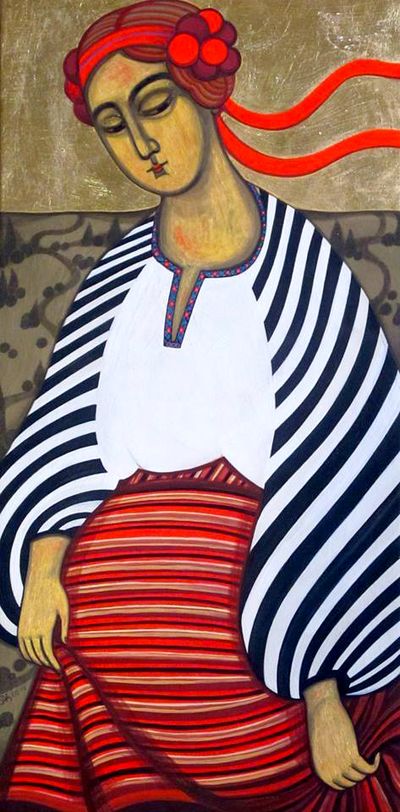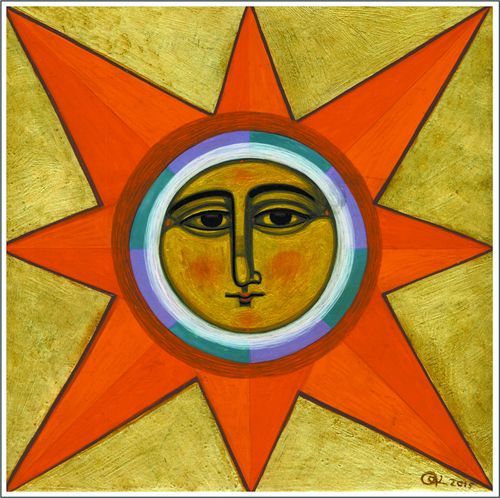Beyond stereotypes
How Ukrainian artist Olha Kravchenko synthesizes contemporary and ancient sacral art works
In 2010, young artists Olha Kravchenko and Yaroslava Tkachuk launched an annual project, “From Roman to Jordan.” It involves Ostap Lozynsky and Uliana Nyshchuk, who paint icons on glass, as well as Olha Pylnyk, Yevhenia Riabchun, and Marian Pyrih, who present ceramics, toys, and exclusive gifts, respectively, and many other artists. Apart from aiming to popularize and make accessible the artworks that overstep the limits of customary exposition spaces, this project encourages artists themselves to experiment with styles.
Let us focus on the oeuvre of one of the abovementioned, Olha Kravchenko, an artist who experiments within the framework of and outside this project, combining icon-painting with installations and multimedia.

Kravchenko has been actively exhibiting her works since 2008, thus developing the traditions of Ukrainian icon-painting. After graduating from an art restoration department in 2008, the artist often took part in restoration practices and scholarship programs. This period shows a combination of antagonistic elements. She turns to Ukrainian icon-painting, on the one hand, and to popular culture, on the other. Indeed, one can see neo-Byzantinism in a number of the artist’s icons – the Byzantine art system has been reconsidered, as far as compositional elements and color planes are concerned. This transformation results in decorativeness and conditionality, which brings Kravchenko’s works closer to the Boichuk school. Taking into account that her grandfather, Okhrim Kravchenko, belonged to Boichuk’s followers, this fact undeniably shows the continuity of a tradition. Like Boichuk’s followers, who focused on folk art, the artist maximally simplifies, quite logically, the iconographic pattern, resorting to expressive disproportions in the depiction of figures. Moreover, this sometimes creates an impression that these disproportions are caused by the form of the material on which the work is done, and vice versa. At the same time, you can feel the Boichuk school’s influence in the aspiration to apply a modern form and coloring to the art of the past. Hence is the simplicity of painting, a refined background, gracefully rhythmic compositions, and perfect knowledge of plane and color. The use of the wooden board, gold, silver, and egg tempera is a basic centuries-old icon-panting technique. Thematically, Kravchenko’s works can be divided into two groups: the first is on religious themes, and the second shows personal intentions.

WITH A FLOWER
Kravchenko is rather consistent in her work. Gradually relieving stress on the plot and the narrative aspect and trying to avoid unnecessary and accidental elements that divert our attention from the work’s idea, the artist gives the sacral work a new content by means of installations and multimedia.

SHEVCHENKO’S KATERYNA
What is assuming importance in this light is the Dough project held in 2010 at Lviv’s “Dzyga” (“Whirligig”) gallery. Big boxes on the gallery’s floor contained the living dough which kept increasing in size and overflowing the molds. The walls displayed some 3D layers that reproduced a maternal womb made of the same dough. Next to this, the video of a child’s intrauterine life was being shown. The project’s message was that humankind is shaped from the same dough, the latter also serving for baking bread, a symbol of human existence. Kravchenko treats dough as the prime source of humankind, drawing parallels with the process of pregnancy: the fruits of pregnancy are people whose body is the dough that transforms into bread which fills deep spatial cavities with its properties. Unlike the previous ones, this project works simultaneously at several levels of perception, and treatment of sacral themes by means of modern-day forms has made the project acceptable in the contemporary art milieu.

ADAM AND EVE
Kravchenko also works on easel sacral pieces that lose erstwhile decorativeness and fall apart into fragments which carry the greatest ideological load. These are usually the images of saints which occupy the board’s entire area (Christmastide Sadness, Annunciation) or a symbol (Crucifixion). A generous inclusion of baroque ornaments and Ukrainian embroidery complements these images. The artist begins to pay more attention to the culture of lines, forms, and composition. The line does not remain passive – it lives on and plastically conveys the form it assumes. All the non-functional and unjustified elements have been dropped. Every artwork displays a better-thought-out synthesis and schematization. In this period, Kravchenko has been creating projects together with Pylnyk (Provocation of Dreams, 2010) and Ostap Lozynsky and Uliana Nyshchuk (Crossover, 2012; 10+10, 2012; Travels, 2013; Bread, 2013). In 2014 she staged a solo exhibit, “The World,” at Lviv’s Ikonart gallery.

STAR
Olha Kravchenko is concurrently experimenting with 3D objects and space. In 2015, she presented, in co-authorship with Yaroslava Tkachuk, the installation Silence and the module composition Mamai’s Shirt – an extremely topical project today. The installation Silence is a video footage projected onto a fiberglass object shaped like a shirt. The video shows a grazing horse. The shirt is interpreted as the symbol of a Cossack who has come back home from the war – the moment when silence reigns, the laundered shirts are hanging to dry, and the horse is grazing. This installation prompts visitors to reflect and communicate, as if they were co-authors.
Olha Kravchenko’s multi-aspect oeuvre reveals her openness to experiment, ability to go through the processes of life, and, at the same time, remain herself – with all her views and persuasions.
Newspaper output №:
№24, (2016)Section
Time Out





